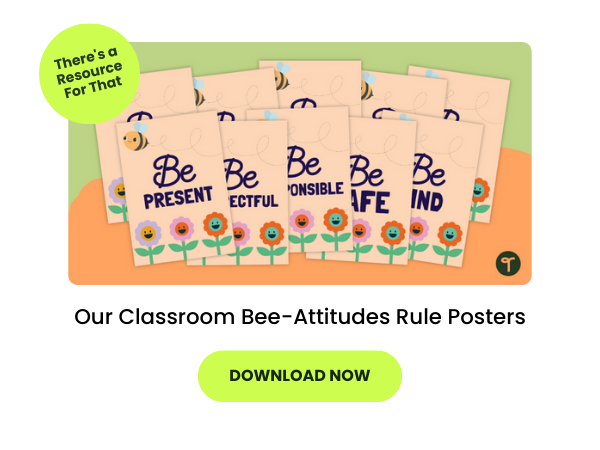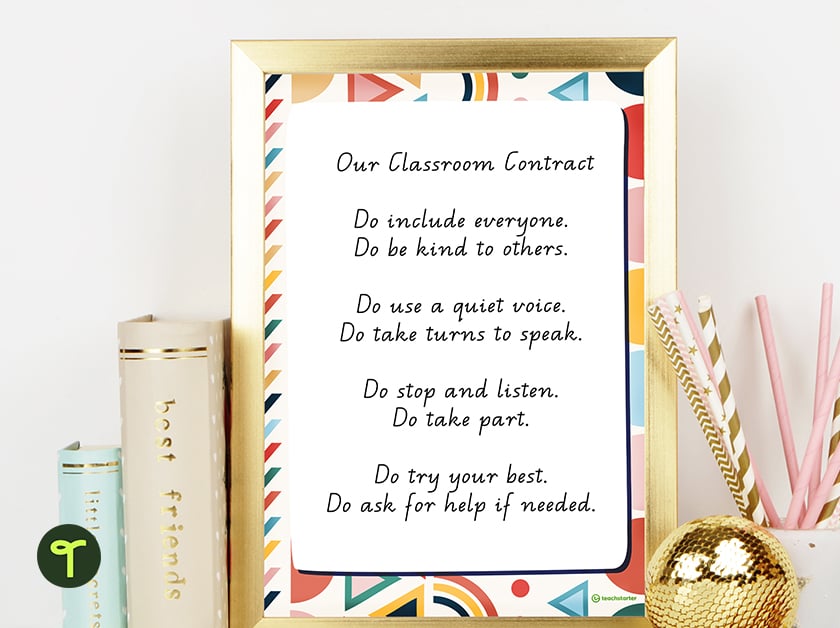
Starting off the school year with a classroom social contract is a good way to let your students know what’s going to be expected of them in the coming weeks and months of the school year and what the consequences will be if they don’t follow the rules. Win, win, right? But all those classroom guidelines and even the consequences aren’t going to mean much if you don’t have student buy-in.
That’s why teachers on the Teach Starter team swear by the process of creating a student-led classroom contract! Thinking this is the year you’ll give the contract a try?
Read on for tips from our teacher team on how social contracts work and how to get students excited about the process of making their own rules (and some rules for you too!).
We may have made you a little nervous with this idea. Rules for you? Made by your students? Let’s back up here for a second and talk about what it means when a student makes a classroom social contract. They aren’t gathering in a pod without you, drafting a bunch of nonsense guidelines that are going to let them eat a lot of candy and ignore their math lessons.
You want to create a collaborative learning experience, right?
Instead of handing your students a list of class rules, and then moving on to the next task on your list, working together with the kids to create a contract makes the learning process more collaborative.
There are many ways to create a student-led classroom social contract with your class, but the following process outlines how to create a contract with students that’s based on our teacher team’s experiences. Feel free to pick and choose the ideas that work for you and your class!
Your class WHY is the purpose, cause, or belief that will drive you to create a student-led classroom contract, to implement it and to stick to it.
Explain to your students that a classroom contract is a written or spoken agreement about how you will make the classroom a great place to learn and have fun. Ask your students the following key questions:

The next step to creating a classroom social contract is to lay the foundations and to discuss the value of respect.
Many of the classroom expectations that will become part of your classroom contract will be based on what we like to call the three pillars of respect :
Ask your students, “What the world would look like without respect?”
Next, encourage your students to start mapping out their perfect classroom with the rules they want to see put in place in their social contract — this is where you really get their buy-in! This is still the brainstorming phase, so no idea is off the table (yet).
An easy way to do this is with our Free Classroom Behavior Task Cards . The task cards have been designed with a small group activity in mind. The prompts on the cards encourage students to think about how positive behaviors might look, sound and feel. The behaviors are linked to respecting self, others and the environment.
The Y-Chart Graphic Organizer is also crying out to be part of the collaborative learning activity — download and print one out for each student!
Here’s one way to do it:
At the end of the learning experience, draw out that in fact, life will feel pretty good in the classroom when there’s a united agreement to respect ourselves, each other, and the environment.

By now, your students will be bursting with ideas about how to make your classroom a great place to be! What’s more, they will know why a classroom social contract is important and how they will benefit.
The next step to creating a classroom contract is to ask your students to think of three behaviors, or actions, that they would like to include in the contract. Encourage your students to start their sentences with “ do ” rather than “don’t.”
It’s a good idea to steer your students’ thinking in the right direction by writing headings on the board that reflect areas of classroom expectation. What these headings are is entirely up to you and your class, but some good areas of classroom expectation you might want to include are:
When your students have thought of three ideas, encourage them to stick them on the board under the corresponding headings.
The next step to creating a classroom contract may be the hardest! It’s time to pick out the most important classroom expectations and put the others to one side. You’ll probably find that there are double-ups and also ideas that can be combined. There is no golden rule about how many classroom expectations you should have, but aim for no more than two per area of expectation in your classroom contract. Any more than this, and your students will find it hard to manage and you’ll find it too hard to implement.
When you have whittled your classroom expectations to a number that works for you and your class, you’re ready! P rint the contract, and post where students can refer back to the agreement.

After all of this hard work, one would like to think that it’s going to last. Unless you make frequent references (we are talking several times each day) to your new classroom contract, it’s likely to evaporate into insignificance. The reality is you’ll need to work on making the rules habit!
Giving explicit praise linked to your classroom contract is crucial. For example, “I am going to give Jayvon a table point because I noticed him looking at Angelina when she was speaking.”
Link your classroom contract to your classroom reward system, and reward your students for upholding their commitment to the classroom contract. Believe us; it’s worth every minute of planning, preparing and doing .